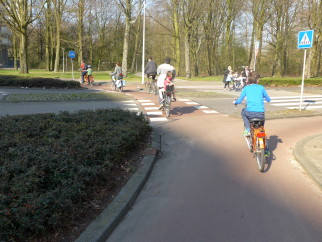There have been a few reports in the media over the past couple of weeks that have caught my eye. Several schools have made the headlines for making decisions and statements about cycling to school.
An independent school in Cambridge is reported to be telling all pupils that they must wear high-visibility clothing and helmets, and not wear headphones. Transgressions to the rules will face a letter home to parents or a detention, and this can apply to cycling both on and off the school premises.
An academy school in St Albans has also decreed that children must not cycle to school on the pavement, and must wear cycle helmets when cycling to school.
Really disappointed with this @SandringhamSch1 – will lead to a) fewer children cycling b) reduced child safety c) more traffic congestion and d) worse pollution. Children should be taught to cycle safely and with care for pedestrians. School could be more robust with complaints pic.twitter.com/uk0cr3vLml
— David Stacey (@staceyzoo) November 9, 2017
However, at the same time, studies have found a “stark” increase in the proportion of children in the UK who are overweight or obese. The study of nearly 12,000 children found 25% were overweight or obese at age seven, rising to 35% at 11.
Surely, given the new research about obesity levels (and we seem to get similar findings reported on a regular basis), combined with ongoing problems with pollution affecting children’s health, shouldn’t every effort be made to get children, of all ages, to cycle or walk to school?
I can see why schools take the path of least resistance when it comes to trying to keep their pupils from upsetting local residents. I also believe that these schools do want to stop their pupils from getting injured (or worse) in accidents. However, punishing children for bad behaviour, or for not wearing a cycle helmet (which is not a legal requirement in the UK), is only tackling a VERY small part of the problem. Yes, I do occasionally see dangerous cycling by some school children – some of which makes me very worried, and I wish someone would educate them into how to ride more safely. But I also sometimes see bad cycling by adults too. This is nowhere near as often as I see dangerous driving by cars, vans and lorries.
None of the people in this picture are wearing helmets or hi-viz. I suspect teachers would take a different view on matters if they had this type of route to their school.

Here’s a short list of things that I believe every school and local authority should be doing, with support from national governments:
- Ensuring that there are safe routes to all schools so children can walk and cycle safely. This does mean spending money on cycling infrastructure, but at some point someone needs to join up the dots. Spiralling health costs, ongoing costs of repairing potholed roads, rising pollution, obesity and stress levels….. each is being tackled in a silo, rather than with joined up policy. Things in Scotland are changing more quickly that elsewhere in the UK
- Making the area in the vicinity of the school safe, so that children can arrive and leave school on foot or bike without the fear of being knocked over by vehicles dropping their class mates off
- Providing all children with practical and regular education on how to cycle and walk safely (such as the Bikeability scheme – but doing this once for a child in their entire education is not enough)
- Providing regular education about the risks of motorised forms of transport, in terms of impact on health, the environment and road traffic accidents. This will stop making those walking and cycling feeling as if they are embarking on a dangerous journey, and help all children realise that every single transport choice has risks and rewards
- During the winter months reinforcement needs to include details about how to be visible to other road users when cycling and walking. However, this education should make children aware of the benefits of ensuring they are visible (and the legal obligations for bike lights), rather than scaring them away from active travel with the “if you’re not wearing hi-vis you’ll get knocked down and it will be your fault” scare tactics
- The use of cycle helmets is not mandatory in the UK, and it would be useful for schools to get children thinking about why these may or may not be appropriate for their journey to school, and when they’re doing other forms of cycling. Care needs to be taken not to make kids feel invincible just because they are wearing a helmet

Photo by Julia Komarova on Unsplash
- Making it easy to cycle (and walk) to school, with plenty of secure cycle storage and places to store cycle helmets and clothing (which may be wet)
- Role modelling, with people who work at schools and local authorities, arriving at school by foot or bike
I’m sure there are other things that can be done to encourage more families to swap the car for a more active school run. I’d love to hear your ideas (or what’s stopping you from making the switch) in the comments below.
Other articles which might be useful:
- How to get more children cycling safely to your school
- How to cycle safely near an HGV
- Is it safe to cycle while pregnant?
- Be bright on your bike now winter is here
If you've enjoyed reading this article, please do sign up for our newsletter - we'll keep up updated when we have new articles which may be of interest. Thanks!

Comments